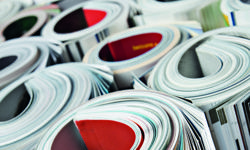
Q: What are the trends in magazine production?
A: I’ve seen two things. Unfortunately, we’ve been hit with multiple paper price increases these last two years. This has made existing publishers of larger run magazines focus on their specs to remain sustainable. As a result, we have seen reductions in paper gsm but they have been applied in an innovative way, combining a significant drop in weight with a magazine redesign. Typically achieved using bulky machine fine coated papers or even high bright newsprint and moving away from traditional glossies. It has worked well for titles that have a strong readership and for free pick-up distribution. These less precious formats focus on the short-term accessibility of good content rather than the repeat read of coffee table style magazines. Tangibly, these still feel substantial but the paper element is significantly cheaper. Also, in complete contrast, we are seeing new, very high quality, short run titles launch from independent publishers. Excellent writing, beautiful design and photography, printed on luxury tactile papers. Leading with a high cover price, they seek to offer a break from the overload of digital we receive. Slow journalism that aims to really engage with us.
Q: What will the print magazine sector look like in ten years’ time?
A: I think the print magazine sector will continue to evolve. It will still be buoyant but it will look very different and be much smaller in terms of the volume of copies any individual magazine puts out. I imagine niche titles will continue to thrive and more small to medium size publishers will emerge. The mainstream magazines currently hanging on and publishing content in print that can be obtained quicker via digital channels will no longer exist. They will have had to reinvent themselves or will have exited the sector. Such is the power of print, I think we will see digital brands use more print to help stimulate their audiences. I don’t believe print will ever disappear totally, it may be used less in certain markets and more in others, but publishers are learning how to integrate print and digital better and will continue to trust it. For some, print will no longer form part of their core offering but it will always serve as a catalyst for the other channels.
Q: What advantages does print have over digital?
A: Digital is more efficient, measurable and it certainly comes at a lower unit cost. But, for me, print provides incredible advantages. Magazines in particular are very effective at targeting customers because they grab attention and create a lasting impression. Print, unlike digital, doesn’t disappear; it has a longer shelf life occupying a breakfast bar or an office desk. Therefore, it’s seen by more people, more often. Print has the power to hold a reader’s attention unlike articles online where you can face many distractions. This is particularly relevant when exploring matters in depth. I think with the high volume of digital communication we receive, a print publication is better placed to increase loyalty. Print requires greater accuracy to produce because it cannot be changed once published. I think for that reason, people subscribe to magazines believing them to be more trustworthy.
Q: How can publishers get their print and digital offerings to work better together?
A: I’m no expert but I see publishers still missing out on the basics of promoting their website, apps, blogs and social media within their print magazine. You can have the best digital offering in the world but if nobody knows about it, then it’s a waste. In many cases, they have an existing platform with the magazine but don’t use this or other direct mail pieces to drive people to their channels. Also, some publishers are still trying to replicate their print magazine on a digital device, which to me is an opportunity missed in terms of giving readers more value and providing a different experience. Engaging effects, additional photography and video can bring an online magazine to life and complement the print edition.
Q: How can publishers give their print magazines more of the ‘wow’ factor?
A: Amazing things can be achieved with print. If budgets were endless, you can go crazy applying scented covers, textured varnishes, foils and latex. You can introduce augmented reality. However, mindful that we are operating in challenging times, most printers can offer something special in house at a more modest price. This is provided you allow time and plan your requirements. Covers can be produced with special colours, metallic inks, UV varnishes, gatefolds and barn door covers. Specific articles within the text pages of your magazine can have prominence with a change of paper stock or adjustment in section size. These things are not revolutionary but they are underutilised which is a shame because they add value, help differentiate and keep readers engaged.
Q: What can publishers do to reduce costs / improve efficiency?
A: It may seem an obvious thing to state but publishers should consult with their printers much more about suitability and efficiency and much earlier in the process when considering new concepts. As new younger buyers enter the market, they can be less informed about print manufacturing but are very competent with digital. There is always a desire to differentiate but it is important that decisions are made with both channels in mind. I am regularly experiencing difficulty where decisions on sizes and pagination are being made prior to liaising with a printer. Sometimes, the sizes cannot physically be produced; if they can, they are limited to just one or two printers or worse still, the spec chosen isn’t suitable for the onward distribution method. Choose a printer that has a clear strategy and are specialists of the products you are trying to deliver.
About us:
Acorn Web Offset is a specialist printer of A4 and A5 multi-pagination magazines. Established over 35 years and operating from arguably one of the UK’s lowest cost production facilities, we currently produce over 250 titles. We support over 90 publishers, providing low-cost magazine print in a no fuss friendly way, with guaranteed on time delivery. Having generated significant growth over the last five years, 2019 is an exciting year as the company implements its largest press investment for twenty years. The new press technology will help ensure the print solutions provided to publishers remains sustainable for many years ahead.
Email: estimating@acornweb.co.uk
Web: www.acornweb.co.uk
Twitter: @AcornWebOffset










